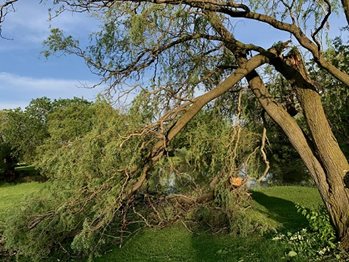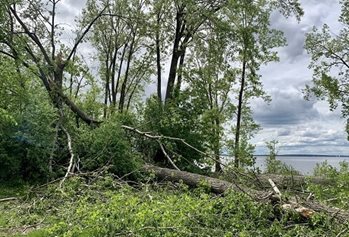 Some of us recently experienced a derecho, even before we may have known what one was.
Some of us recently experienced a derecho, even before we may have known what one was.What is a derecho?
A derecho is a strong storm, often with torrential downpours and high-speed winds, that is categorized by the shape of its path: straight lines, instead of spirals that would indicate a hurricane or tornado.
Recently, a derecho with 130-km winds hit parts of Ontario and Quebec, resulting in widespread devastation, including the loss of 10 lives, and power outages for several days.
In Canada, strong storms such as these can – and do – happen at anytime and anywhere. How can you protect yourself and loved ones from future storms, including tornadoes and power outages? We have some safety practises and tips for you here.
How to stay safe in future storms
 Derechos are not as common in Canada as in the U.S. However, severe thunderstorms are very common in Canada at anytime, anywhere. Tornado season is April to September in Canada but, more recently, can occur at any time of the year.
Derechos are not as common in Canada as in the U.S. However, severe thunderstorms are very common in Canada at anytime, anywhere. Tornado season is April to September in Canada but, more recently, can occur at any time of the year.Power outages are also common as temperatures and storm conditions increase.
The best way to protect yourself and your family in case of a storm is to follow these steps:
- Prepare for secondary risks such as flooding, power outages, landslides, and damaged buildings.
- Pay attention to weather warnings. Thunderstorms, tornadoes, and hurricanes are tracked before they occur. Visit Environment Canada for up-to-date information on storm conditions, storm maps and weather warnings.
- Make a personalized preparedness emergency kit. Families should be prepared to be self-sustaining for at least three days.
- Kits should include practical items such as drinking water, food, cash, and a portable radio. However, they should also include items that are unique to your own families’ needs. This could include baby items, medical prescriptions, pet food, etc.
- Have a plan in place: Ensure the entire family is prepared and informed in the event of a disaster or emergency as you may not always be together when these events take place and should have a home plan for making sure you are able to contact and find one another.
Prepare for high winds:Download a Home Plan Template, also available in: French, Spanish, Punjabi, Chinese simplified, Chinese traditional, Arabic
Derechos produce high-speed winds. In the recent derecho, a tornado touched down in Uxbridge, Ontario.
Winds within a tornado can reach speeds of up to 500 km/h, and regardless of size, tornadoes have the ability to uproot trees, flip cars and damage homes. The best way to protect yourself and your family in case of a tornado is to follow these steps:
- Pay attention to weather watches and warnings.
- Move your family to a safe location on the lowest level of a building. Stay away from windows, outside walls and doors.
- Know your tornado risk by contacting your local authorities. Know how warnings are given for tornadoes and ensure your family is familiar with the alert.
- Visit Environment Canada for up-to-date information on tornado conditions, storm maps and weather warnings.
Prepare for power outages:
Power outages are so closely tied to weather. Listen to local news and weather reports for information on changing weather conditions. You can stay informed by following storm warnings and weather forecasts through Public Weather Alerts Canada. Here are more tips to plan for a power outage:
- Plan for persons with functional needs such as essential medical equipment or mobility issues. Consider how they may be affected in a power outage – for example, if you are without elevator service.
- Know where municipality shelters are located.
- Protect all your sensitive electrical appliances with a surge-protecting power bar.
- If you are considering getting a generator, get advice from a professional, like an electrician. Make sure the generator you purchase is rated for the power that you think you will need.
- Make sure your home has a working carbon monoxide detector. If it’s hard-wired to the house’s electricity supply, make sure it has a battery-power back-up.
- Make sure you keep a flashlight with working batteries in a place that is easily accessible and where everyone can find it.
- Have a non-powered phone available. Landlines may still work without power.
- Keep your gas tank at least half full.
Related stories:

